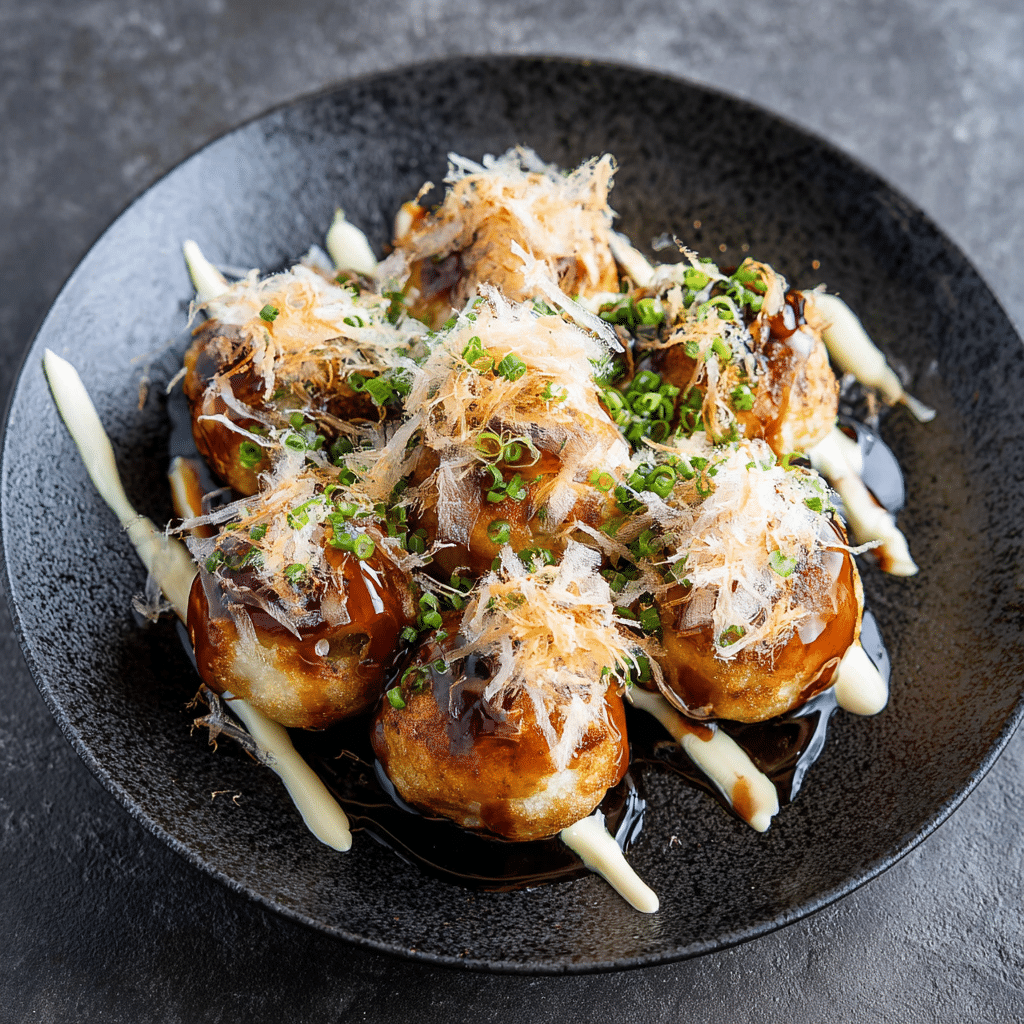Bringing the vibrant spirit of Osaka’s streets into your home, these Takoyaki Bites are irresistible little spheres of joy. Each ball delivers a burst of umami from tender octopus, fragranced with green onion and pickled ginger, all wrapped in a delicate, crisp batter. Topped with traditional takoyaki sauce, mayonnaise, bonito flakes, and a sprinkle of green seaweed, they’re perfect for gatherings or a cozy night in.
Perfect for those craving something fun, shareable, and bursting with flavor. Easy to make even with minimal equipment—a takoyaki pan—and rewarding every step of the way. Whether you’re introducing Japanese snacks to friends or treating yourself, these golden octopus delights are sure to impress and become a house favorite.
Full Recipe
Ingredients:
-
1 cup all‑purpose flour
-
2 large eggs
-
2 cups dashi stock (or water + instant dashi)
-
1 tsp soy sauce
-
1 tsp baking powder
-
100 g cooked octopus, finely chopped
-
2 tbsp green onion, thin‑sliced
-
1 tbsp pickled ginger, chopped
-
1 tbsp tempura scraps (tenkasu)
-
Vegetable oil for greasing
Directions:
-
In a bowl, whisk together flour, eggs, dashi and soy sauce until smooth.
-
Heat a takoyaki pan over medium heat; brush each cavity with oil.
-
Pour batter to fill each hole about ¾ full.
-
Immediately add a piece of octopus to each cavity, then sprinkle green onion, ginger, and tenkasu evenly.
-
When edges begin to set (about 1–2 min), use picks or skewers to turn each ball 90°, letting uncooked batter flow out.
-
Continue turning the balls every 30 sec, browning evenly, until golden and crisp (3–4 min).
-
Transfer to plate; top with takoyaki sauce, mayonnaise, bonito flakes, and aonori.
Prep Time: 10 min | Cooking Time: 15 min | Total Time: 25 min | Kcal: approx. 60 kcal per ball | Servings: about 20 pieces
What is Takoyaki?
Takoyaki, literally translating to “grilled octopus,” is one of Japan’s most beloved street foods, especially popular in the Kansai region and originating from Osaka. These round, golden-brown savory balls are made from a wheat flour batter and traditionally filled with small pieces of cooked octopus (tako), green onions, pickled ginger, and crunchy tempura scraps (tenkasu). Cooked in a specially designed takoyaki pan with half-sphere molds, the batter is poured in, then turned carefully with skewers to create perfectly round, crispy-on-the-outside and soft-on-the-inside bites.
The finished takoyaki are usually topped with takoyaki sauce (similar to Worcestershire sauce, but thicker and sweeter), creamy Japanese mayonnaise, shaved bonito flakes (katsuobushi), and powdered seaweed (aonori). Served piping hot, these delightful bites are bursting with umami and offer a balance of textures that make them uniquely satisfying.
The Origins and Cultural Significance of Takoyaki
Takoyaki was invented in Osaka in 1935 by a street vendor named Tomekichi Endo. Inspired by akashiyaki—a softer, eggier dumpling from the city of Akashi—Endo created a more robust and accessible version that quickly grew in popularity. Today, takoyaki stands are found in nearly every Japanese city, especially during festivals, street markets, and in popular nightlife areas.
The dish has since become a symbol of Japanese comfort food, often shared in social settings, cooked at home during casual gatherings, and featured in anime, dramas, and pop culture as an icon of Japanese street cuisine. It represents the communal joy of cooking together and the casual charm of Osaka’s food culture.
Why People Love Takoyaki
Takoyaki is more than just food—it’s an experience. From the aroma that draws you in at a festival to the sizzling sound of batter hitting a hot pan, everything about takoyaki engages the senses. When made fresh, the crisp outer layer contrasts perfectly with the molten, savory interior. The bite-sized format makes them easy to eat, and the variety of toppings provides an explosion of flavor that lingers.
What’s more, takoyaki is endlessly customizable. While the classic version features octopus, variations can include shrimp, cheese, sausage, or even vegetarian fillings like mushrooms or kimchi. The recipe adapts well to different preferences, making it a fun and inclusive dish for home cooks and street vendors alike.
Takoyaki at Home vs. Street Stalls
There’s a special charm to eating takoyaki at a bustling street stall, surrounded by lively crowds and the excitement of a festival. However, making takoyaki at home is becoming increasingly popular. With the availability of affordable electric or stovetop takoyaki pans, people around the world can recreate the magic in their own kitchens.
Homemade takoyaki allows for experimentation—not only with fillings but also with sauces, batter consistency, and toppings. Hosting a “takoyaki party” (often called a “tako-pa” in Japan) has become a favorite casual social event, where guests take turns flipping the balls, customizing flavors, and bonding over the shared activity. It’s interactive, fun, and deeply satisfying.
Tips for Making Perfect Takoyaki
While making takoyaki is not overly difficult, it does require practice, especially when it comes to flipping the batter at the right time to achieve a round shape. Here are a few expert tips to help home cooks master the process:
-
Preheat the pan well before adding oil to ensure an even, crisp base.
-
Use a piping bag or a jug with a spout for neat batter pouring.
-
Don’t overfill the pan. It’s okay for the batter to overflow slightly—this helps shape the balls—but too much can make them hard to flip.
-
Be patient when turning. Start by pushing the cooked edge inward, allowing uncooked batter to flow out and continue cooking. Keep rotating until they form a sphere.
-
Use authentic toppings. A drizzle of takoyaki sauce and mayo, a sprinkle of aonori, and a handful of bonito flakes bring the full flavor profile to life.
Modern Variations of Takoyaki
Modern chefs and home cooks have embraced takoyaki’s versatility, creating innovative takes on the classic dish. Some popular variations include:
-
Cheese Takoyaki: Melty cheese added to the center for a gooey surprise.
-
Korean-Inspired Takoyaki: Incorporating spicy gochujang and kimchi for an extra kick.
-
Seafood Mix Takoyaki: Replacing octopus with shrimp, crab, or scallops.
-
Vegetarian Versions: Using mushrooms, tofu, or plant-based meat alternatives for a meatless option.
-
Dessert Takoyaki: Swapping savory ingredients for sweet batter and fillings like chocolate, custard, or mochi for a fun twist.
Each variation adds its own flair while keeping the comforting core of takoyaki intact.
Takoyaki Around the World
Thanks to the spread of Japanese cuisine globally, takoyaki has made its way to food festivals, restaurants, and street fairs in cities across Asia, Europe, and the Americas. It is often featured in Japanese izakayas and fusion street food spots. Foodies outside Japan are increasingly embracing the dish, appreciating its rich flavor, uniqueness, and social nature.
You’ll find it in modern bento boxes, served as appetizers in upscale restaurants, and even frozen in supermarkets for convenience. Its appeal crosses borders and cultures, turning a humble Osaka street snack into a global culinary trend.
Takoyaki vs. Other Japanese Street Foods
While takoyaki is undeniably iconic, it shares the spotlight with other Japanese street foods such as okonomiyaki (savory pancakes), yakisoba (fried noodles), taiyaki (fish-shaped filled pastries), and karaage (Japanese fried chicken). What sets takoyaki apart is its spherical shape and molten interior, offering a different texture and eating experience.
Its preparation technique—turning the batter into balls as they cook—is distinct and adds an element of fun and skill. Unlike larger dishes, takoyaki is compact and quick to prepare, making it a top choice for snacking on the go or as part of a shared meal.
The Health Factor: Is Takoyaki Healthy?
Takoyaki is generally considered a treat food—rich, flavorful, and best enjoyed in moderation. Each ball contains roughly 60–70 calories, depending on the fillings and toppings. While it is deepened with umami-rich ingredients and protein from the octopus, it is still fried and often topped with mayonnaise and sauce.
For a healthier version, you can:
-
Use whole wheat or gluten-free flour for the batter.
-
Replace octopus with lean proteins like tofu or shrimp.
-
Use low-calorie toppings or limit sauces.
-
Skip the mayo or use a light version.
Even with these adjustments, the joy of takoyaki remains intact—it’s all about balance and how often you indulge.
Conclusion: Why Takoyaki Deserves a Place in Your Kitchen
Takoyaki is more than just a snack—it’s an experience that brings people together. Whether you’re discovering it for the first time or recreating it at home to share with friends, the dish offers a unique blend of culture, flavor, and fun. It connects you to the heart of Japanese street food, evokes memories of festivals, and delivers warm, savory satisfaction with each bite.
Its versatility makes it suitable for all occasions—from casual dinners and game nights to themed parties and food explorations. With a little practice and the right tools, takoyaki can become a new staple in your culinary repertoire—something to be made, shared, and enjoyed with delight.
Takoyaki is a reminder that great food isn’t just about ingredients—it’s about community, creativity, and joy. So next time you’re looking to try something new, fire up your takoyaki pan, invite some friends over, and enjoy the magic of these golden octopus delights.






